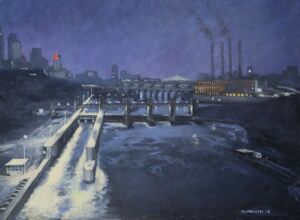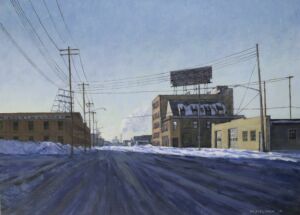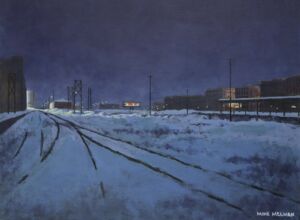
Lock and Dam No. 2, Mississippi River, Minneapolis, 2013. Acrylic on Paper.
“American cities change at a frightening speed, usually with little regard for the past…It saddens me to think that some of my older photographs may be the only visual record of buildings and streetscapes that no longer exist and would otherwise be forgotten. Certainly, they deserved a better fate.” Mike Melman, from The Quiet Hours, 2003
Born in the Bronx in 1939, artist Mike Melman’s childhood inspired his fascination with American urban landscapes. His reverence for history and the built environment echoes loudly throughout his quiet scenes. These gloomy and desolate cityscapes, devoid of people, pay homage to the monuments of Minnesota’s industrial past that are often ignored or unappreciated.
Melman began painting at an early age and received formal training in New York at the High School of Music & Art and the Cooper Union, before graduating with a bachelor’s degree in architecture from the University of California Berkeley in 1962. Melman then worked in New York, London (where he met and married his wife Lotte Wallner in 1969), and in the Twin Cities before his retirement.

North 1st Street, Minneapolis, 2014. Acrylic on Paper.
Despite a long and successful career as an architect, Melman’s real passion was art. In addition to painting, he developed a talent for photography in 1967, before moving to Minneapolis in 1972. Never seeing anything like them before, Melman was captivated by the flour mills and grain elevators so commonplace in the Mill City. He began exploring his new environment and found beauty where others would not in the aging buildings, railroads, and bridges he discovered throughout.
According to the artist, he felt compelled to photograph the unused or abandoned relics before they disappeared. He’d wake up late at night and venture out to capture their quiet beauty in the tranquil, early morning hours before most people were awake. Melman’s work is haunting because of what is depicted and what isn’t: people and automobiles. However, there is occasionally evidence of humanity, such as smoke billowing out of a stack, or electric lights shining in the darkness, which adds nuance to the silence of his work.

Westside Milling District, Minneapolis, circa 2015. Acrylic on Paper.
Though best known for black and white photography, Melman’s first love was painting. And the mood, style, and nostalgia found in his art remains constant throughout his oeuvre. His work is quiet, humble, and sentimental, all words that could also describe Melman himself.
In his lifetime, Melman’s paintings and photographs were exhibited at various museums and galleries around the Twin Cities and published in Architecture Minnesota and Minnesota Monthly. His book, The Quiet Hours, a collection of seventy photographs taken from around the state, was published in 2003.

Nicolet Island Railroad Bridge, 2017. Acrylic on Paper.
Melman passed away in 2021, leaving behind a legacy and large body of work. His wife Lotte has been diligently donating his works to the various institutions where they belong. Fourteen of these works, all depicting Minneapolis cityscapes, were donated to Hennepin History Museum in 2023. In these paintings, created in the years before his death, Melman worked from photographs he took years and sometimes decades earlier. These works are currently on display in Haunting Beauty: Relics of the Mill City through the end of 2024.
By: Alyssa Thiede, HHM Curator
2/28/2024
